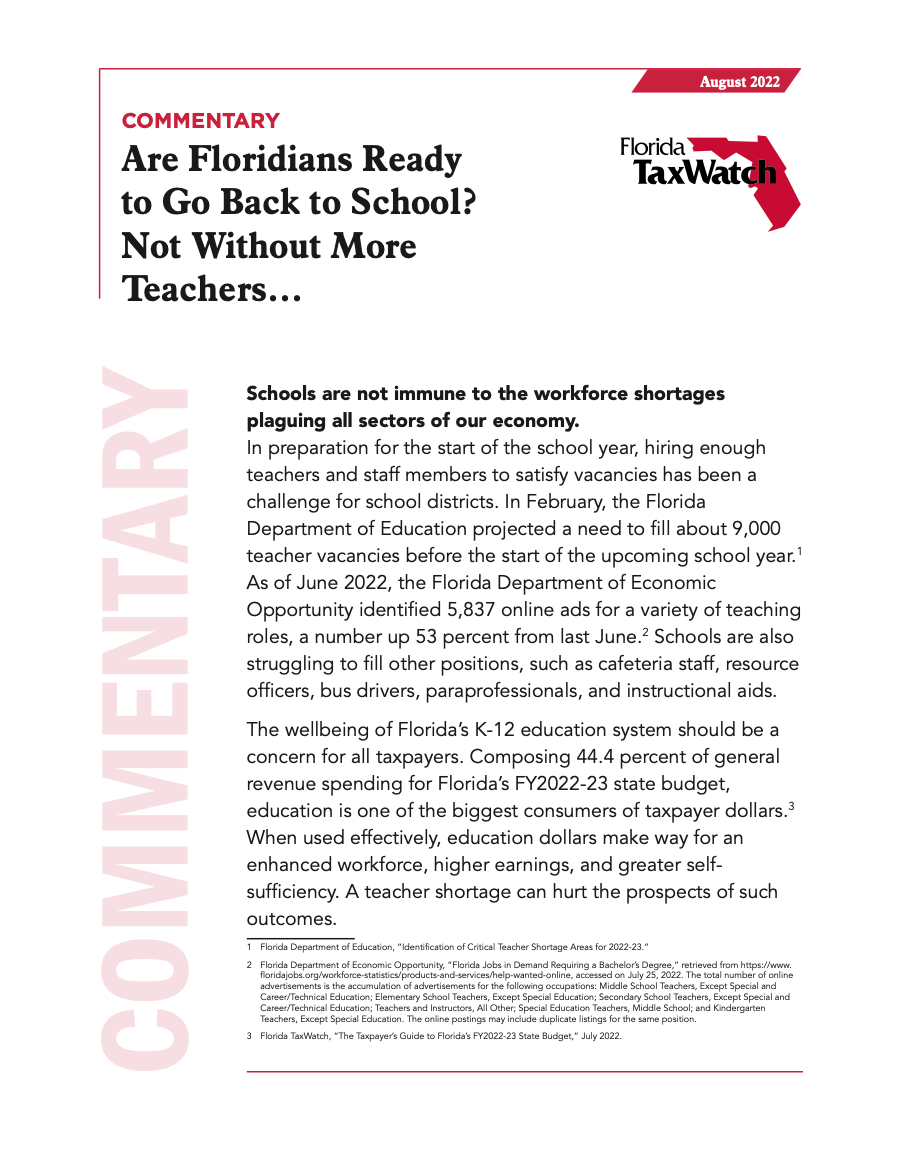Are Floridians Ready to Go Back to School? Not Without More Teachers...

Schools are not immune to the workforce shortages plaguing all sectors of our economy. In preparation for the start of the school year, hiring enough teachers and staff members to satisfy vacancies has been a challenge for school districts. In February, the Florida Department of Education projected a need to fill about 9,000 teacher vacancies before the start of the upcoming school year. As of June 2022, the Florida Department of Economic Opportunity identified 5,837 online ads for a variety of teaching roles, a number up 53 percent from last June. Schools are also struggling to fill other positions, such as cafeteria staff, resource officers, bus drivers, paraprofessionals, and instructional aids.
The well-being of Florida’s K-12 education system should be a concern for all taxpayers. Composing 44.4 percent of general revenue spending for Florida’s FY2022-23 state budget, education is one of the biggest consumers of taxpayer dollars. When used effectively, education dollars make way for an enhanced workforce, higher earnings, and greater self-sufficiency. A teacher shortage can hurt the prospects of such outcomes.
How Does the Teacher Shortage Affect Schools?
Without a ready pool of applicants, vacancies cause rippling consequences. Administrators use time and money to find short-term and long-term ways to adapt. Meanwhile, the disruption of finding and onboarding new teachers can cause a loss of student learning time. The remaining teachers may feel pressured to take on new responsibilities, such as increasing class sizes (though the size must abide by the bounds set by Florida’s constitution), teaching an additional class during planning periods, serving as substitute teachers—possibly while maintaining their own class—and mentoring new teachers. These newfound responsibilities can fuel stress and burnout, which may not only lead to the departure of additional teachers but can also cause community members to perceive education as a field not worth pursuing.
Additionally, when the right candidate cannot be found, schools may accept less qualified candidates. Florida’s teacher shortage is so severe that about 10 percent of teachers active during the 2021-22 school year lacked certifications appropriate to their field.
Why is Florida Struggling to Find Teachers?
There are several factors commonly cited as reasons against pursuing or continuing teaching careers. First is compensation. The latest data release from the National Center of Education Statistics shows Florida’s average annual salary of teachers in public elementary and secondary schools at $49,583, ranking second to last among the states and 17 percentage points below the national average. Adjusting for changes to currency, Florida’s average annual teaching salary has fallen by about 13 percent since the 2009-10 school year. Another frequently discussed deterrent, especially since the onset of the COVID-19 pandemic, is the considerable pressure the job places upon mental health. A recent survey suggests that more teachers are ready to depart. In January 2022, the National Education Association found that 55 percent of educators are considering leaving their profession earlier than planned. With rising costs and inflationary pressures burdening the bills, as well as lingering COVID-19 health concerns and new instructional expectations enhancing stress, attracting and retaining teachers, could become an increasingly difficult challenge.
How Has Florida Reacted?
- Increasing Pay. $800 million was allocated to raise Florida’s minimum teacher pay and to boost the salary of veteran teachers.
- Supporting Homeownership. Among 50 critical professions, educators are eligible participants in the Florida Hometown Heroes Housing Program. The program helps first-time, income-qualified homebuyers by assisting with down payments and closing costs. The assistance is a loan—not a gift—but the loan has zero percent interest and does not need to be paid until mortgage payments are complete.
- Facilitating Pathways from the Military to Teaching. In 2022, Florida forged an additional pathway to teaching: military veterans qualify for a five-year, nonrenewable temporary educator certification if they served at least 48 months of active-duty and earned at least 60 college credits. For the first time, no bachelor’s degree is required.
How Have School Districts Reacted?
- Building Affordable Housing. As rising prices make house-hunting increasingly difficult in Southwest Florida, Collier County plans to help teachers by building essential temporary housing on a 35-acre parcel of unused property.
- Inviting Teachers from Other Countries. Florida often recruits teachers from other states, but since the whole nation struggles from the weight of teacher shortages, Osceola County has begun looking beyond the country.
- Strengthening the Talent Pipeline. Hillsborough County School District built partnerships with nearby universities and colleges to launch the Transformation Fellowship Program.
- Removing Disincentives. Since 2011, Escambia County School District has required all employees to remain tobacco-free. As of July 2022, this policy has been temporarily lifted to increase the applicant pool.
There are no easy solutions for state and local leaders grappling with the effects of teacher shortages, and as leaders try to balance quality versus quantity, Florida residents will feel the impact of their choices. If the applicant pool remains limited, administrators may be less likely to replace ineffective teachers and schools may be more prone to mid-year vacancies that disrupt student learning. If the applicant pool is expanded by lowering teacher education requirements, schools may be at risk of offering a lower quality of education to students. If monetary means—such as raises or subsidized training programs—are used to attract and retain teachers, residents may incur the cost through additional taxes. As leaders decide the best way to confront the teacher shortages in their communities, balancing educational needs to available resources will continue to be a challenge.